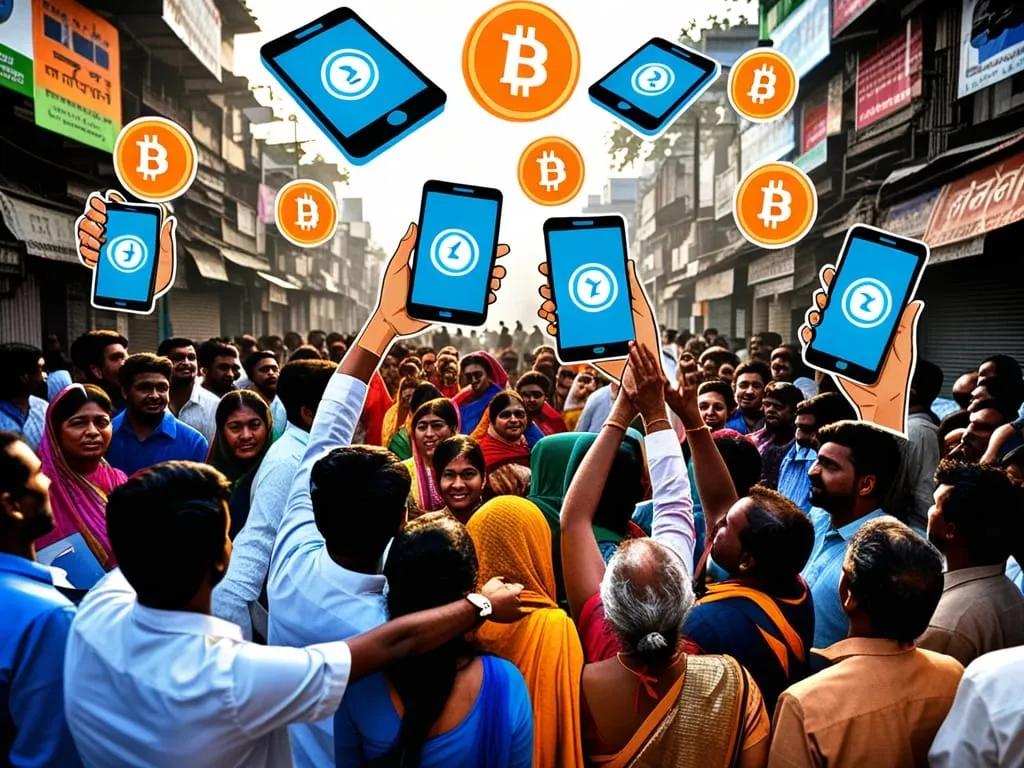In the bustling streets of India, a silent revolution is underway, one that is transforming the way people think about and interact with financial services. This revolution is driven by Decentralized Finance, or DeFi, a concept that is as simple as it is powerful: providing financial services without the need for traditional banks or intermediaries.
Imagine Rekha, a small-scale entrepreneur in a remote village, who has always struggled to access loans from traditional banks. The process is cumbersome, involving long journeys to the nearest bank, endless paperwork, and often, a rejection at the end of it all. But with DeFi, Rekha can now access loans with just her smartphone. She doesn’t need to leave her village or deal with the red tape that has long been a barrier to financial inclusion.
The Birth of DeFi
The rise of DeFi can be traced back to the launch of Bitcoin in 2009, which introduced the concept of decentralized, peer-to-peer digital currency. However, it wasn’t until around 2020 that DeFi started to gain significant traction. The total value of crypto assets locked in DeFi transactions, known as Total Value Locked (TVL), skyrocketed from less than $1 billion in 2019 to over $100 billion by the end of 2021. This rapid growth indicates a gradual but firm adoption of DeFi applications, with around 4 million unique addresses now using these services.
How DeFi Works
At the heart of DeFi is blockchain technology, which allows for the creation of a decentralized, public ledger. This ledger records financial transactions as computer code, making the entire process transparent and secure. Unlike traditional banking systems, where transactions are entered into private ledgers controlled by financial organizations, DeFi operates on decentralized blockchain networks.
For instance, if Rekha wants to lend out her Ethereum (ETH) to earn interest, she can deposit it into a decentralized lending protocol like Aave. This protocol automatically matches her with borrowers and executes the loan via a smart contract, which is a self-executing contract with predefined rules. The interest is determined by supply and demand, and Rekha earns a portion of it, all without any human intermediaries.
Democratizing Finance
DeFi is not just about lending and borrowing; it encompasses a wide range of financial services, including trading, yield generation, and even insurance. Decentralized Exchanges (DEXs) like Uniswap allow users to trade cryptocurrencies directly from their wallets, bypassing the need for centralized exchanges. These DEXs use automated market makers (AMMs) to determine prices and liquidity, making trading more decentralized and accessible.
The democratization of finance through DeFi is particularly significant in India, where a substantial portion of the population remains unbanked. According to recent reports, India has surpassed 154 countries in terms of DeFi adoption, with 17.6% of Indian crypto investments parked in DeFi utility tokens. This adoption is driven by the increasing demand for decentralized financial services that are more accessible, transparent, and inclusive than traditional finance.
Financial Inclusion
DeFi is often described as the industrial revolution of our time, and its impact on financial inclusion is profound. It allows individuals from any part of the world to participate in the global economy, regardless of their geographic location or socioeconomic status. For people like Rekha, who have been excluded from the formal banking system, DeFi offers a lifeline.
In India, where digital penetration is on the rise, especially among the younger generation, DeFi is becoming a viable alternative to traditional banking. It provides more transparency, programmability, and accessibility than traditional systems. For example, decentralized lending protocols can offer loans to small-scale entrepreneurs who would otherwise be denied credit by traditional banks.
Cost Efficiency and Innovation
One of the significant advantages of DeFi is its cost efficiency. By removing intermediaries, DeFi dramatically lowers the cost of financial services. Traditional finance is often burdened by high fees, long processing times, and bureaucratic red tape. In contrast, DeFi allows for near-instant transactions with significantly lower fees, particularly when using blockchain platforms with low transaction costs.
Innovation is another key driver of DeFi’s growth. Traditional financial institutions are increasingly exploring the potential of DeFi, experimenting with blockchain technology and DeFi protocols to offer new products and services. This integration between decentralized and centralized finance could lead to hybrid systems that combine the best of both worlds.
Challenges and Regulatory Uncertainties
Despite its potential, DeFi is not without its challenges. Security concerns, regulatory uncertainties, and the complexity of navigating DeFi platforms pose significant hurdles. The lack of clear regulatory frameworks in many countries, including India, exposes investors and the financial system to multiple risks.
For DeFi to achieve its full potential, regulatory collaboration and disclosure are essential. There is a need for standardized, easy-to-read disclosures to clearly inform investors about the risks and benefits of crypto assets. Regulatory bodies must create guidelines that protect users while fostering innovation.
The Future of DeFi in India
The future of DeFi in India looks promising. With the correct legislative framework and greater public education, DeFi has the potential to transform India’s financial landscape. It could drive financial inclusion, foster innovation, and empower individuals to take control of their financial future.
India’s experience with the Unified Payments Interface (UPI) offers a glimpse into what DeFi could achieve. UPI has revolutionized digital payments in India, making transactions fast, secure, and accessible. Similarly, DeFi could democratize finance, giving people the ability to access loans, savings, and investment opportunities that were previously out of reach.
Empowering Young India
For young Indians, DeFi represents a new frontier in financial empowerment. It allows them to diversify their portfolios through new-age investments like cryptocurrency and DeFi utility tokens. The younger generation, more tech-savvy and open to innovation, is driving the adoption of DeFi in India.
However, for DeFi to become mainstream, there is a need for greater education and awareness. Users must be well-informed about the crypto assets they are investing in, and the industry must provide clear, easy-to-read disclosures. This will help build confidence and investment in the crypto market.
Conclusion
The rise of DeFi in India is a story of innovation, inclusion, and empowerment. It is about creating a financial system that is open, transparent, and accessible to all. While challenges remain, the potential of DeFi to transform India’s economic landscape is undeniable.
As we look to the future, it is clear that DeFi is here to stay. It is not just a trend but a fundamental shift in how we think about finance. For Rekha and millions like her, DeFi offers a chance to participate in the global economy, to access financial services that were once out of reach. This is the true power of DeFi—a power that could change the face of finance in India and beyond.






